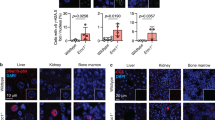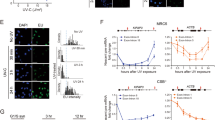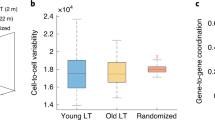Abstract
The accumulation of DNA damage and mutations is considered a major cause of cancer and aging. While it is known that DNA damage can affect changes in gene expression, transcriptional regulation after DNA damage is poorly understood. We characterized the expression of 6912 genes in human primary fibroblasts after exposure to three different kinds of cellular stress that introduces DNA damage: 4-nitroquinoline-1-oxide (4NQO), γ-irradiation, or UV-irradiation. Each type of stress elicited damage specific gene expression changes of up to 10-fold. A total of 85 genes had similar changes in expression of 3–40-fold after all three kinds of stress. We examined transcription in cells from young and old individuals and from patients with Werner syndrome (WS), a segmental progeroid condition with a high incidence of cancer, and found various age-associated transcriptional changes depending upon the type of cellular stress. Compared to young individuals, both WS and old individuals had similarly aberrant transcriptional responses to γ- and UV-irradiation, suggesting a role for Werner protein in stress-induced gene expression. Our results suggest that aberrant DNA damage-induced gene regulation may contribute to the aging process and the premature aging in WS.
This is a preview of subscription content, access via your institution
Access options
Subscribe to this journal
Receive 50 print issues and online access
$259.00 per year
only $5.18 per issue
Buy this article
- Purchase on Springer Link
- Instant access to full article PDF
Prices may be subject to local taxes which are calculated during checkout






Similar content being viewed by others
Abbreviations
- WS:
-
Werner syndrome
- CV:
-
coefficient of variation
- EST:
-
expressed sequence Tag
- 4-NQO:
-
4-nitroquinoline-1-oxide
- H-ESR:
-
human environmental stress response
- PDL:
-
population doubling
- IE:
-
immediate-early gene
- GO:
-
gene ontology™
References
Bakay M, Chen YW, Borup R, Zhao P, Nagaraju K and Hoffman EP . (2002). BMC Bioinformatics, 3, 4.
Brazma A, Hingamp P, Quackenbush J, Sherlock G, Spellman P, Stoeckert C, Aach J, Ansorge W, Ball CA, Causton HC, Gaasterland T, Glenisson P, Holstege FC, Kim IF, Markowitz V, Matese JC, Parkinson H, Robinson A, Sarkans U, Schulze-Kremer S, Stewart J, Taylor R, Vilo J and Vingron M . (2001). Nat. Genet., 29, 365–371.
Busuttil RA, Rubio M, Dolle ME, Campisi J and Vijg J . (2003). Aging Cell, 2, 287–294.
Chen YW, Zhao P, Borup R and Hoffman EP . (2000). J. Cell Biol., 151, 1321–1336.
Choi D, Whittier PS, Oshima J and Funk WD . (2001). FASEB J., 15, 1014–1020.
Collier IE, Popp DM, Lee WH and Regan JD . (1982). Mech. Ageing Dev., 19, 141–146.
Davis T, Singhrao SK, Wyllie FS, Haughton MF, Smith PJ, Wiltshire M, Wynford-Thomas D, Jones CJ, Faragher RG and Kipling D . (2003). J. Cell Sci., 116, 1349–1357.
Fan J, Yang X, Wang W, Wood III WH, Becker KG and Gorospe M . (2002). Proc. Natl. Acad. Sci. USA, 99, 10611–10616.
Friedberg EC, Walker GC and Siede W . (1995). DNA Repair and Mutagenesis. ASM Press: Washington, DC.
Gasch AP and Werner-Washburne M . (2002). Funct. Integr. Genom., 2, 181–192.
Gebhart E, Bauer R, Raub U, Schinzel M, Ruprecht KW and Jonas JB . (1988). Hum. Genet., 80, 135–139.
Guehenneux F, Duret L, Callanan MB, Bouhas R, Hayette S, Berthet C, Samarut C, Rimokh R, Birot AM, Wang Q, Magaud JP and Rouault JP . (1997). Leukemia, 11, 370–375.
Hasty P, Campisi J, Hoeijmakers J, van SH and Vijg J . (2003). Science, 299, 1355–1359.
Hilsenbeck SG, Friedrichs WE, Schiff R, O'Connell P, Hansen RK, Osborne CK and Fuqua SA . (1999). J. Natl. Cancer Inst., 91, 453–459.
Huang Q, Liu D, Majewski P, Schulte LC, Korn JM, Young RA, Lander ES and Hacohen N . (2001). Science, 294, 870–875.
Jelinsky SA, Estep P, Church GM and Samson LD . (2000). Mol. Cell. Biol., 20, 8157–8167.
Jones CJ, Edwards SM and Waters R . (1989). Carcinogenesis, 10, 1197–1201.
Kayo T, Allison DB, Weindruch R and Prolla TA . (2001). Proc. Natl. Acad. Sci. USA, 98, 5093–5098.
Kruk PA, Rampino NJ and Bohr VA . (1995). Proc. Natl. Acad. Sci. USA, 92, 258–262.
Kyng KJ, May A, Brosh Jr RM, Cheng WH, Chen C, Becker KG and Bohr VA . (2003a). Oncogene, 22, 1135–1149.
Kyng KJ, May A, Kolvraa S and Bohr VA . (2003b). Proc. Natl. Acad. Sci. USA, 100, 12259–12264.
Lambert B, Ringborg U and Skoog L . (1979). Cancer Res., 39, 2792–2795.
Lawrance IC, Fiocchi C and Chakravarti S . (2001). Hum. Mol. Genet., 10, 445–456.
Lee CK, Klopp RG, Weindruch R and Prolla TA . (1999). Science, 285, 1390–1393.
Lee CK, Weindruch R and Prolla TA . (2000). Nat. Genet., 25, 294–297.
Lee J, Dawes IW and Roe JH . (1995). Microbiology, 141 (Part 12), 3127–3132.
Ljungman M and Lane DP . (2004). Nat. Rev. Cancer, 4, 727–737.
Lu T, Pan Y, Kao SY, Li C, Kohane I, Chan J and Yankner BA . (2004). Nature, 429, 883–891.
Ly DH, Lockhart DJ, Lerner RA and Schultz PG . (2000). Science, 287, 2486–2492.
Matsumoto T, Shimamoto A, Goto M and Furuichi Y . (1997). Nat. Genet., 16, 335–336.
Miller RA, Galecki A and Shmookler-Reis RJ . (2001). J. Gerontol. A Biol. Sci. Med. Sci., 56, B52–B57.
Moggs JG and Orphanides G . (2003). Toxicol. Lett., 140–141, 149–153.
Moradas-Ferreira P and Costa V . (2000). Redox. Rep., 5, 277–285.
Murano S, Thweatt R, Shmookler Reis RJ, Jones RA, Moerman EJ and Goldstein S . (1991). Mol. Cell. Biol., 11, 3905–3914.
Nakura J, Ye L, Morishima A, Kohara K and Miki T . (2000). Cell. Mol. Life Sci., 57, 716–730.
Nantel A, Dignard D, Bachewich C, Harcus D, Marcil A, Bouin AP, Sensen CW, Hogues H, van het HM, Gordon P, Rigby T, Benoit F, Tessier DC, Thomas DY and Whiteway M . (2002). Mol. Biol. Cell, 13, 3452–3465.
Niedermuller H, Hofecker G and Skalicky M . (1985). Mech. Ageing Dev., 29, 221–238.
Ogburn CE, Oshima J, Poot M, Chen R, Hunt KE, Gollahon KA, Rabinovitch PS and Martin GM . (1997). Hum. Genet., 101, 121–125.
Opresko PL, Cheng WH, von Kobbe C, Harrigan JA and Bohr VA . (2003). Carcinogenesis, 24, 791–802.
Ostermeier GC, Dix DJ, Miller D, Khatri P and Krawetz SA . (2002). Lancet, 360, 772–777.
Park WY, Hwang CI, Kang MJ, Seo JY, Chung JH, Kim YS, Lee JH, Kim H, Kim KA, Yoo HJ and Seo JS . (2001). Biochem. Biophys. Res. Commun., 282, 934–939.
Parrinello S, Samper E, Krtolica A, Goldstein J, Melov S and Campisi J . (2003). Nat. Cell Biol., 5, 741–747.
Poot M, Yom JS, Whang SH, Kato JT, Gollahon KA and Rabinovitch PS . (2001). FASEB J., 15, 1224–1226.
Prince PR, Ogburn CE, Moser MJ, Emond MJ, Martin GM and Monnat Jr RJ . (1999). Hum. Genet., 105, 132–138.
Seluanov A, Mittelman D, Pereira-Smith OM, Wilson JH and Gorbunova V . (2004). Proc. Natl. Acad. Sci. USA, 101, 7624–7629.
Smith L and Greenfield A . (2003). Hum. Mol. Genet., 12 (Spec. No. 1), R1–R8.
Snyderwine EG and Bohr VA . (1992). Cancer Res., 52, 4183–4189.
Volkert MR and Landini P . (2001). Curr. Opin. Microbiol., 4, 178–185.
von KC, May A, Grandori C and Bohr VA . (2004). FASEB J., 18, 1970–1972.
Webb DK, Evans MK and Bohr VA . (1996). Exp. Cell Res., 224, 272–278.
Weindruch R, Kayo T, Lee CK and Prolla TA . (2001). J. Nutr., 131, 918S–923S.
Weirich-Schwaiger H, Weirich HG, Gruber B, Schweiger M and Hirsch-Kauffmann M . (1994). Mutat. Res., 316, 37–48.
Welle S . (2002). Exp. Gerontol., 37, 583–590.
Welle S, Brooks A and Thornton CA . (2001). Physiol. Genom, 5, 67–73.
Xu G, Snellman E, Bykov VJ, Jansen CT and Hemminki K . (2000). Mutat. Res., 459, 195–202.
Yang L, Li N, Wang C, Yu Y, Yuan L, Zhang M and Cao X . (2004). J. Biol. Chem., 279, 11639–11648.
Zahn RK, Zahn-Daimler G, Ax S, Reifferscheid G, Waldmann P, Fujisawa H and Hosokawa M . (2000). Mech. Ageing Dev., 119, 101–112.
Zou S, Meadows S, Sharp L, Jan LY and Jan YN . (2000). Proc. Natl. Acad. Sci. USA, 97, 13726–13731.
Acknowledgements
This work was supported by the Danish Center for Molecular Gerontology, Aarhus Universitets Forskningsfond (E-2002-SUN-3-11), Lundbeckfonden (117/02), and The Danish Cancer Society (DS 04 024). We thank members of the laboratory for reading and comments.
Author information
Authors and Affiliations
Corresponding author
Additional information
Supplementary Information accompanies the paper on Oncogene website (http://www.nature.com/onc)
Rights and permissions
About this article
Cite this article
Kyng, K., May, A., Stevnsner, T. et al. Gene expression responses to DNA damage are altered in human aging and in Werner Syndrome. Oncogene 24, 5026–5042 (2005). https://doi.org/10.1038/sj.onc.1208692
Received:
Revised:
Accepted:
Published:
Issue Date:
DOI: https://doi.org/10.1038/sj.onc.1208692
Keywords
This article is cited by
-
Senescence, regulators of alternative splicing and effects of trametinib treatment in progeroid syndromes
GeroScience (2023)
-
Investigating the impact of long term exposure to chemical agents on the chromosomal radiosensitivity using human lymphoblastoid GM1899A cells
Scientific Reports (2021)
-
Human WRN is an intrinsic inhibitor of progerin, abnormal splicing product of lamin A
Scientific Reports (2021)
-
p21 suppresses inflammation and tumorigenesis on pRB-deficient stratified epithelia
Oncogene (2014)
-
4-Nitroquinoline-1-Oxide-Induced Mutagen Sensitivity and Risk of Nonmelanoma Skin Cancer: A Case–Control Analysis
Journal of Investigative Dermatology (2007)



